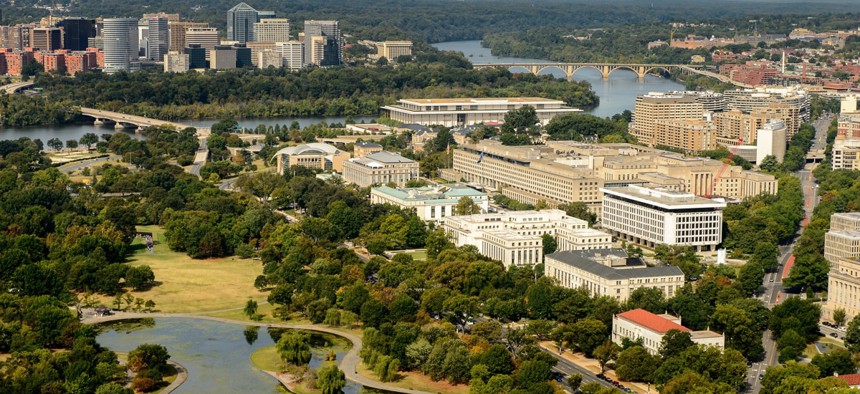D.C. Has to Work Around a White House That Denies Climate Change to Prepare for a 500-Year Flood

The city needs the federal government's cooperation to make its climate-change resiliency plan work.
Donald Trump has repeatedly denied the existence of human-made climate change, and since taking control of the White House, his administration has moved swiftly to dismantle former president Barack Obama’s climate legacy. It has withdrawn from the Paris Climate agreement, making it literally the only country that has not signed on. Trump’s Environmental Protection Agency, led by Scott Pruitt, is in the process of dismantling the Obama administration’s Clean Power Plan. And on Monday (Dec. 4), the administration terminated a cross-agency group that helped prepare cities for the consequences of climate change.
In the city whose soil the White House is built on, however, local officials have been acting in accordance with the verified science, preparing for the increased risk of flooding and extreme temperatures expected in the coming decades. On Dec. 5, the C40 Cities Bloomberg Philanthropies Awards recognized Washington, D.C., as one of 10 cities around the world leading the way in climate-change action.
Led by D.C.’s municipal Department of Energy & Environment, the Climate Ready D.C. Plan pulls together 77 actions that focus on improving the resilience—for example, the ability to withstand extreme heat, weather, and flooding—of the city’s infrastructure and its communities.
It was adopted in November 2016, but many of its actions are not new, according to a DOEE spokesperson. The plan incorporated some of the government efforts already underway, such as managing stormwater with green infrastructure and creating energy-efficient building codes, into a larger holistic strategy. Now, the municipal agency is reaching out to the private sector to help improve infrastructure resiliency.
“There’s a lot of new development happening in the city, so there’s a big opportunity to do it right,” the spokesperson says. “We’re already beginning to push developers for new development to build to the 500-year flood”—a flood with a magnitude that supposedly has a one in 500 chance of occurring in a given year, adds Tommy Wells, director of the DOEE. “Historically, you built to the 100-year flood,” he says, but due to climate change, the 500-year-magnitude flood could easily come at the rate expected of 100-year or even 10-year floods.
In the short term, one to three years, the plan includes assessing the vulnerability of the city’s transportation, utility systems, and buildings, and educating communities about disaster preparedness and response. In the medium- and long-term, up to 20 years, it includes revamping infrastructure regulations to prepare for extreme heat and sea-level rise, evaluating and educating residents about the health risks of climate change, and helping low-income communities develop “resilience hubs” that offer resources like food and health services in an emergency.
But being the White House’s hometown puts D.C. in a difficult position. “The federal government owns almost 30% of the land in the district,” Wells says, if you include the land it leases. Because D.C.’s resiliency plan relies heavily on infrastructure changes, the federal government’s cooperation is of utmost importance. As a tenant of the city, the federal government pays the same city fees as everyone else. For example, says Wells, “we put a surcharge on everybody’s power bill to help pay for investing in solar in the city and that surcharge goes on the federal government’s bill as well.”
The real question, though, is whether the federal government will continue to abide by D.C.’s building code and development regulations if those in charge don’t like them. The supremacy of federal law, Wells says, means the Trump administration technically doesn’t have to listen to D.C. But Wells doesn’t believe the administration will break from convention, because of the federal government’s “substantial interest in protecting its own assets,” he says.
That said, it is possible that the administration could stop investing in climate change mitigation. For example, the federal government currently requires all the buildings that they occupy to meet LEED Gold certification and Energy Star standards, Wells says. Under an administration that doesn’t believe humans are impacting the climate, there’s no certainty the government will maintain those standards.
“That is the drama that’s being played out as we speak,” Wells says.
Karen Hao is a tech fellow at Quartz, where this article was originally published.
NEXT STORY: New RAND Study Pushes Back on Descriptions of Widespread Crumbling Infrastructure in U.S.





